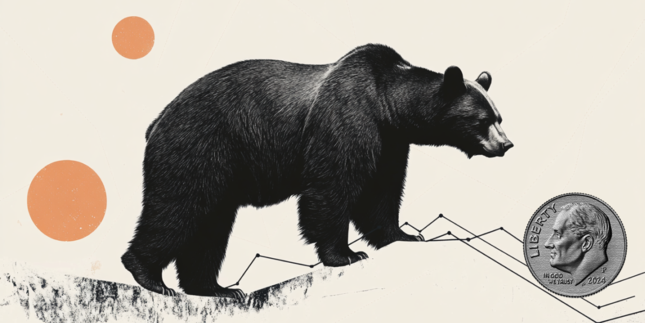Dự báo và tin tức USD/CAD
USD/CAD kéo dài chuỗi thua lỗ trong ngày giao dịch thứ tư
Cặp USD/CAD kéo dài chuỗi giảm giá của mình trong ngày giao dịch thứ tư vào thứ Sáu. Cặp Loonie giao dịch thấp hơn 0,1% gần mức 1,3750 trong giờ giao dịch châu Âu. Cặp tiền này đang chịu áp lực khi đồng đô la Mỹ hoạt động kém, sau thông báo chính sách tiền tệ của Cục Dự trữ Liên bang vào thứ Tư.
Tin tức mới nhất về đồng Đô la Canada
Tổng quan kỹ thuật USD/CAD
Tổng quan cơ bản
Phân tích CAD mới nhất
Lựa chọn từ ban biên tập

Thống đốc Fed Paulson: Thị trường việc làm đang chịu áp lực nhưng chưa gãy
Thống đốc Ngân hàng Dự trữ Liên bang (Fed) Philadelphia Anna Paulson cho biết hôm thứ Sáu rằng việc cắt giảm lãi suất đã "loại bỏ một số biện pháp bảo hiểm" chống lại rủi ro thị trường việc làm.

Dự báo giá Ripple: XRP mở rộng tích luỹ trên mức hỗ trợ 2,00$
Ripple (XRP) đang tiếp tục giao dịch đi ngang trên mức hỗ trợ 2,00 đô la vào thời điểm viết bài này vào thứ Sáu, khi dư âm từ quyết định của Cục Dự trữ Liên bang (Fed) lắng xuống.

Dự báo giá vàng: XAU/USD vẫn sẵn sàng để lấy lại mốc 4.300$ và tiếp tục tăng cao hơn
Vàng đang củng cố ngay dưới mức cao nhất trong bảy tuần là 4.286 đô la vào đầu ngày thứ Sáu, hướng tới mức tăng khoảng 2% trong tuần.

Bitcoin và Ethereum hướng đến sự bứt phá, Ripple ổn định tại mức hỗ trợ
Bitcoin và Ethereum đang tiến gần đến các mức kháng cự chính tại thời điểm viết vào thứ Sáu, và một sự bứt phá thành công có thể mở ra cơ hội cho một đợt tăng giá mới. Trong khi đó, Ripple đang ổn định xung quanh một vùng hỗ trợ quan trọng, gợi ý về một sự hồi phục tiềm năng nếu người mua duy trì quyền kiểm soát.

Dưới đây là những điều bạn cần biết vào thứ Sáu, ngày 12 tháng 12:
Dưới đây là những gì bạn cần biết vào thứ Sáu, ngày 12 tháng 12:
Các cặp tiền tệ chính
Tiền điện tử
Tin nổi bật
DỰ BÁO USD/CAD HÀNG NĂM
USD/CAD sẽ biến động ra sao trong năm nay? Các chuyên gia của chúng tôi cập nhật dự báo USD/CAD, dự đoán những biến động có thể xảy ra của cặp Đô la Canada (CAD) – Đô la Mỹ (USD) trong suốt cả năm. Đừng bỏ lỡ dự báo USD/CAD năm 2025 của chúng tôi!
DỰ BÁO USD/CAD NĂM 2025
Trong Dự báo USD/CAD năm 2025, nhà phân tích Joshua Gibson của FXStreet cho rằng sự không chắc chắn và tâm lý né rủi ro có thể khiến đồng Đô la Mỹ (USD) mạnh lên vào đầu năm 2025, trong khi đồng Đô la Canada (CAD) được dự đoán sẽ suy yếu trong quý đầu tiên. Tuy nhiên, các nhà đầu tư CAD có thể xem xét lại triển vọng khi năm tiến triển, tập trung vào sự khác biệt trong chính sách giữa Cục Dự trữ Liên bang Mỹ (Fed) và Ngân hàng Trung ương Canada (BoC).
Về mặt kỹ thuật, USD/CAD có thể gặp ngưỡng cản kỹ thuật quanh mức 1.4400 sau khi đồng CAD giảm mạnh 8,5% trong năm 2024, đưa cặp tiền này lên mức cao nhất trong 56 tháng. Tuy nhiên, các chỉ báo kỹ thuật như MACD cho thấy cần thận trọng, vì các vị thế bán có thể chỉ khả thi khi xuất hiện tín hiệu bán rõ ràng, nhiều khả năng xảy ra trong quý đầu tiên.
Đọc toàn bộ dự báo năm 2025.
CÁC YẾU TỐ ẢNH HƯỞNG LỚN NHẤT ĐẾN USD/CAD TRONG NĂM 2025
Năm nay sẽ bị chi phối về mặt chính trị bởi sự trở lại Nhà Trắng của ông Trump. Một chính phủ Cộng hòa được xem là tích cực đối với thị trường tài chính, nhưng cam kết cắt giảm thuế và áp thuế đối với hàng hóa và dịch vụ nước ngoài của Trump có thể tạo ra sự bất ổn trong cả bối cảnh chính trị lẫn kinh tế.
Cuộc khủng hoảng chính trị ở Canada đã lên đến đỉnh điểm vào cuối năm 2024 với cuộc bỏ phiếu bất tín nhiệm nhằm vào Thủ tướng Justin Trudeau, dẫn đến bầu cử sớm và một chính phủ thiểu số Đảng Tự do suy yếu. Sự bất ổn chính sách và những thách thức kinh tế chi phối triển vọng năm 2025, làm dấy lên lo ngại về sự ổn định thị trường và niềm tin của nhà đầu tư.
BoC dự kiến sẽ tiếp tục nới lỏng lãi suất trong suốt năm 2025, ít nhất là với tốc độ nhanh hơn so với Fed, điều này có thể gây áp lực lên chênh lệch lãi suất vốn đã tăng của đồng CAD.
CÁC TỔ CHỨC VÀ NHÂN VẬT CÓ ẢNH HƯỞNG ĐẾN USD/CAD
Ngân hàng Trung ương Canada (BoC)
Ngân hàng Trung ương Canada (BoC) là ngân hàng trung ương của quốc gia. Vai trò chính của ngân hàng, theo Đạo luật Ngân hàng Trung ương Canada, là “thúc đẩy phúc lợi kinh tế và tài chính của Canada.” Các nhiệm vụ của ngân hàng được chia thành bốn lĩnh vực chính:
-
Chính sách tiền tệ: Ngân hàng điều tiết cung tiền trong nền kinh tế, sử dụng khuôn khổ chính sách tiền tệ nhằm duy trì lạm phát ở mức thấp và ổn định.
-
Hệ thống tài chính: Ngân hàng thúc đẩy các hệ thống tài chính an toàn, lành mạnh và hiệu quả trong nước và quốc tế, thực hiện các giao dịch trên thị trường tài chính để hỗ trợ các mục tiêu này.
-
Tiền tệ: Ngân hàng thiết kế, phát hành và phân phối tiền giấy Canada.
-
Quản lý quỹ: Ngân hàng là đại lý tài chính của Chính phủ Canada, quản lý các chương trình nợ công và dự trữ ngoại hối của chính phủ.
Ngân hàng Trung ương Canada (BoC) quyết định lãi suất và điều hành chính sách tiền tệ trong tám cuộc họp định kỳ mỗi năm, cùng với các cuộc họp khẩn khi cần thiết. Nhiệm vụ chính của BoC là duy trì sự ổn định giá cả, tức là giữ lạm phát trong khoảng 1-3%. Công cụ chính để đạt được mục tiêu này là điều chỉnh lãi suất. Lãi suất tương đối cao thường dẫn đến đồng Đô la Canada (CAD) mạnh hơn, và ngược lại. Các công cụ khác được sử dụng bao gồm nới lỏng và thắt chặt định lượng.
Trang web chính thức, trên X và YouTubeCục Dự trữ Liên bang Mỹ (Fed)
Cục Dự trữ Liên bang Mỹ (Fed) là ngân hàng trung ương của Hoa Kỳ, với hai mục tiêu chính: duy trì tỷ lệ thất nghiệp ở mức thấp nhất có thể và giữ lạm phát quanh mức 2%. Cơ cấu của Hệ thống Dự trữ Liên bang bao gồm Ban Thống đốc do Tổng thống Mỹ bổ nhiệm và Ủy ban Thị trường Mở Liên bang (FOMC) được bổ nhiệm một phần. FOMC tổ chức tám cuộc họp định kỳ mỗi năm để đánh giá tình hình kinh tế và tài chính. Cơ quan này cũng quyết định định hướng chính sách tiền tệ phù hợp và đánh giá các rủi ro đối với các mục tiêu dài hạn là ổn định giá cả và tăng trưởng kinh tế bền vững. Biên bản cuộc họp của FOMC, được công bố bởi Ban Thống đốc Fed vài tuần sau cuộc họp gần nhất, đóng vai trò định hướng cho chính sách lãi suất tương lai của Mỹ.
Trang web chính thức của Fed, trên X và FacebookJerome Powell
Jerome Powell nhậm chức Chủ tịch Hội đồng Thống đốc của Hệ thống Dự trữ Liên bang vào tháng 2 năm 2018 với nhiệm kỳ bốn năm kết thúc vào tháng 2 năm 2022. Ông tuyên thệ nhậm chức nhiệm kỳ thứ hai vào ngày 23 tháng 5 năm 2022, kết thúc vào ngày 15 tháng 5 năm 2026. Sinh ra tại Washington D.C., ông nhận bằng cử nhân chính trị tại Đại học Princeton năm 1975 và bằng luật tại Đại học Georgetown năm 1979. Powell từng giữ chức Trợ lý Bộ trưởng và Thứ trưởng Bộ Tài chính dưới thời Tổng thống George H.W. Bush. Ông cũng từng làm luật sư và nhân viên ngân hàng đầu tư tại thành phố New York. Từ năm 1997 đến 2005, ông là đối tác tại Tập đoàn Carlyle.
Jerome Powell Hồ sơ của Fed và
Wikipedia
Tiff Macklem
Tiff Macklem sinh năm 1961 tại Montreal, Quebec. Ông được bổ nhiệm làm Thống đốc Ngân hàng Trung ương Canada từ ngày 3 tháng 6 năm 2020 với nhiệm kỳ bảy năm. Ông tốt nghiệp Đại học Queen's với bằng cử nhân kinh tế và hoàn thành bằng thạc sĩ cùng bằng tiến sĩ kinh tế tại Đại học Western Ontario.
Trước khi trở thành Thống đốc, Macklem từng là giám đốc của Ngân hàng Nova Scotia và là chủ tịch ủy ban quản lý rủi ro của ngân hàng này. Ông hiện là chủ tịch Nhóm Thống đốc và Người đứng đầu Cơ quan Giám sát – cơ quan giám sát của Ủy ban Basel về Giám sát Ngân hàng – và là đồng chủ tịch Nhóm Tham vấn Khu vực Châu Mỹ của Hội đồng Ổn định Tài chính.
TIN TỨC & PHÂN TÍCH BOC
TIN TỨC & PHÂN TÍCH FED
Về cặp tiền tệ USD/CAD
TẦM QUAN TRỌNG CỦA DẦU MỎ ĐỐI VỚI ĐỒNG 'LOONIE'
USD/CAD là một trong ba "cặp tiền hàng hóa", cùng với AUD/USD và NZD/USD. Các cặp tiền tệ này gắn chặt với biến động giá hàng hóa, đặc biệt là dầu mỏ.
Canada, được biết đến là một nền kinh tế dựa vào tài nguyên, là nhà sản xuất và cung cấp dầu lớn. Thị trường xuất khẩu chính của nước này là Hoa Kỳ, khiến đồng Đô la Canada (CAD) đặc biệt nhạy cảm với dữ liệu tiêu dùng và sức khỏe kinh tế của Mỹ.
Giá dầu tăng thường có tác động tiêu cực đến USD và tác động tích cực đến CAD.
CÁC TÀI SẢN ẢNH HƯỞNG MẠNH NHẤT ĐẾN USD/CAD
- Trái phiếu: CSB (Trái phiếu Tiết kiệm Canada), CPB (Trái phiếu Cao cấp Canada) và T-Note 10Y (Trái phiếu Kho bạc Mỹ kỳ hạn 10 năm).